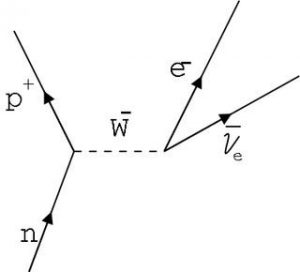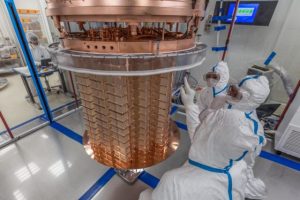Perhaps the most sophisticated, sensitive experiment even attempted is the Cryogenic Underground Observatory for Rare Events or CUORE now underway at Laboratori Nazionali del San Grasso in Italy. To order to give you an idea of just what lengths the scientists have gone to in order to achieve such sensitivity the researchers boast of having build “the coldest cubic meter of space in the known Universe!”
And they’re going to need it; the CUORE team are looking for subatomic events so rare that they happen once or twice a year in 100 kilograms worth of atoms. The specific reaction that the CUORE team is studying is the extremely rare double beta decay, they’re trying to see whether or not two neutrinos are produced, as the Standard Model of Elementary Particles requires.
Let me take a step back and describe single beta decay first. Back in the early 20th century physicists found three distinct types of radiation, alpha, beta and gamma rays. Beta radiation was found to occur when a neutron broke up into a proton and an electron, the electron is the high energy beta particle. Problem was that some of the energy of the neutron went missing, an apparent violation of the law of conservation of energy. It was the physicist Wolfgang Pauli who suggested in 1935 that there was another particle as well, a neutral particle with little or no mass that would be very difficult to detect. The image below shows a Feynman diagram of the beta decay process (The W particle in the middle is the boson that carries the weak nuclear interaction). Detecting neutrinos turned out to be so difficult that in fact it took experimentalists 25 years to finally prove that the neutrino was real.

Single neutrino decay happens quite often, in fact a free neutron, one not in a nucleus will undergo beta decay with a half life of about 12 minutes. (See my post of 4Mar2017). Double beta decay, where two neutrons simultaneously decay to two protons and two electrons, is far rarer and was only proven to exist in 1987.
Now it’s been suggested that double beta decay might not produce any neutrinos! This would require the neutrino to be its own anti-particle so that they would annihilate each other. Such a reaction would be a violation of conservation of lepton number, a key element of the Standard Model of elementary particles. So physicists are very interested in the possibility of neutrinoless double beta decay. The image below shows the Feynman diagrams for double beta decay with and without neutrinos.

There are several reasons why physicists are so interested in neutrinoless double beta decay. One is that it would indicate a possible channel to explain why there is more matter in our Universe than anti-matter while at the same time it could also enable us to measure the tiny rest mass of the neutrino.
Now as I said double beta decay is very rare. You need to observe all of the atoms in kilograms of a material that is capable of double beta decay in order to see one or two a year! And then you have to measure the total energy of both of the electrons to make certain that they got it all, with no neutrinos the electrons get all of the kinetic energy generated.
The experiment the CUORE team has developed uses a device known as a bolometer that will actually measure the heat generated by a single subatomic event. There are 988 total bolometers composed of crystals made from the chemical TeO2 where Te is the element whose isotope Te130 is capable of double beta decay. It is in order to measure the tiny amount of energy released by the double beta decay that all 988 bolometers have to be maintained at the unbelievably cold temperature of 10mK (That’s 10 thousandths of a degree above absolute zero Kelvin), the coldest place in the known Universe. The image below shows the detector ‘towers’ ready to be installed in the cold chamber.

Before I forget I need to mention that in order to prevent radiation from outside, primarily cosmic rays, interfering with the measurements the detectors are first wrapped in lead shielding and then the entire experiment is buried deep underground.
The CUORE collaboration, which consists of over 150 scientists from around the world, have just released the results of the first year of the experiment and so far it looks like the standard model still stands. The CUORE team puts the half-life of a neutrinoless double beta decay at greater than 1.5 x 10^25 years. That doesn’t mean that neutrinoless double beta decay never happens, you can never prove something never happens, it means on average you’ll have to wait 15,000,000,000,000,000,000,000,000 years to see a nucleus of Te130 produce a neutrinoless double beta decay.
The CUORE experiment will continue to gather data, looking not only for neutrinoless double beta decay but also for possible signs of minute interactions between the material in the detectors and hypothetical Dark Matter particles called ‘WIMPS’, Weakly Interacting Massive Particles.
Another thing I like about CUORE however is that it is a search for new physics at low energy; it is an experiment that doesn’t need the huge particle accelerators like those at CERN or Fermilab. I hope CUORE does find new physics of some kind and I’ll let you know when it does.

Hellow my name is MartinSen. Wery proper art! Thx 🙂
Thanks for the comment Martin. I’m glad you like the site and I hope you’ll keep coming back.
Bob L
When I originally commented I clicked the “Notify me when new comments are added” checkbox and now each
time a comment is added I get several e-mails with the same comment.
Is there any way you can remove me from that service?
Thanks!
finanzas personales
I searched through all of my comment and apparently this is you first one! I’m afraid I don’t know what else to do!
Bob L
Aw, this was an exceptionally nice post. Taking the time and actual effort to produce a great article… but what
can I say… I put things off a whole lot and don’t seem to get anything
done.
Thanks for the comment. The only way to get anything done is to just DO IT!!!!
Bob L
I’ve read some just right stuff here. Definitely price bookmarking for revisiting.
I surprise how much effort you place to create the sort of wonderful informative site.
Thanks for the comment and come back soon!
Bob L
Hey there! I’m at work browsing your blog from my new iphone!
Just wanted to say I love reading through your blog and look forward to all your
posts! Keep up the excellent work!
Thanks for the comment and come back soon!
Bob L
Thank you for some other wonderful post. Where else
could anyone get that type of information in such an ideal
approach of writing? I’ve a presentation next week, and I am on the search
for such information.
Thanks for the comment and come back soon!
Bob L
If some one wishes expert view concerning running a blog then i propose him/her to pay
a visit this web site, Keep up the good job.
Thanks for the comment and come back soon!
Bob L